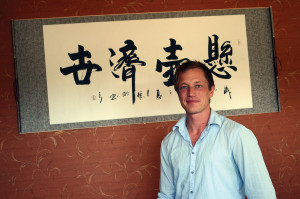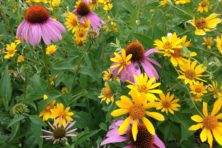Holistic Medicine
- Share
- Tweet
- Pin
- Share
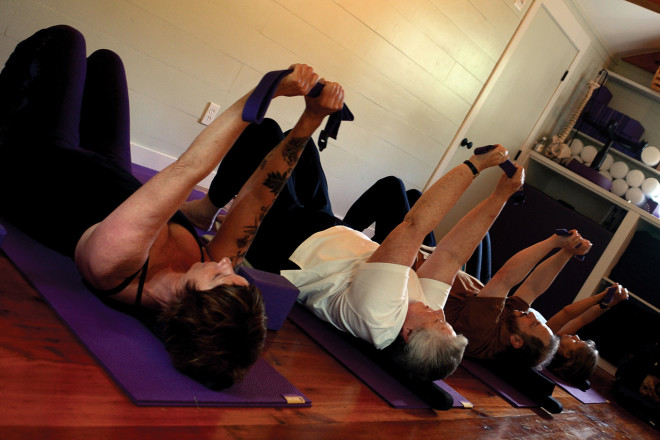
I’m not afraid of needles. Still, when I lay back on the table and saw the fleet of sharp shiny tools, I wasn’t thrilled. Whoever discovered that pushing needles into his body was therapeutic must have been nuts.
Nuts, but right.
So began my first acupuncture treatment. I had met with Alison Beadell of Wood Rabbit Acupuncture on a sunny Saturday morning to talk about the trade. After she explained the basics of meridians in the body and the benefits of balancing qi, Beadell took me to her studio at Lori’s Spa Essence for a treatment of my own.
Beadell usually spends a lot of time going over a patient’s health history and diagnosing any health issues before she gets started, but I was just in for the experience.
After showing me some of her equipment, like mugwort and other herbs, a hand-held SCENAR device and cups for cupping therapy, my treatment started. I lay down on the bed, looked inwardly for a moment and tried not to think about what was happening as Beadell pushed the first needle into my hand.
I felt the needle in my skin, but it wasn’t painful. It even felt like a release of tension, and I began to see how needles could fit into relaxation. After seven more needles in my arms, legs and feet, and 20 minutes lying down in a warm, dark room I was convinced.
Acupuncture was only one step in my journey to learn about the holistic health options Door County has to offer. I met with a critical alignment and yoga instructor, an herbalist, and bodywork practitioners from the Nelson Healing Center to discuss the options for staying healthy without relying on pharmaceutical medicine or trips to the doctor.
I first wanted to learn what “holistic health” meant to these healthcare providers, who made their livings on the principle.
For Beadell, holistic care means providing the answer to a health issue, not just masking problems with medicines.
“You figure out what’s going on with the body versus masking the pain,” Beadell said. “You treat the root cause versus the branch.”
For critical alignment therapist Theresa Evans, owner of Stone Path Yoga Studio, holistic care means getting the whole self – the mind, heart and body – involved in the healing process.
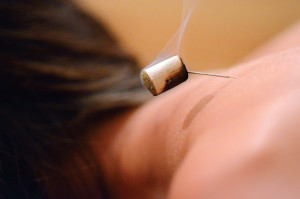
“It’s the whole package,” Evans said. “All of me being completely present.”
At the Nelson Healing Center in Sturgeon Bay, the practice of working across forms of treatment embodies holistic care. When a patient comes in with a health issue, Nelson Healing Center employees collaborate to decide what treatment is best for the patient. They work with each other to enhance every aspect of a patient’s health.
Herbalist Elizabeth Moriarty also sees holistic healthcare as focusing on the whole person, because aspects of health are interdependent. Each part of the body, like the mind, the gut or the skin, affects the health of the whole body.
“Holism is the practice of recognizing the integration of all of an individual being’s needs as a whole,” Moriarty said.
These healthcare practitioners agreed that Western medicine has its place. I think Antonia Nelson put it best when she said that if your arm is broken and spurting blood you should go to a hospital, not in for a massage.
They agreed that the Western medical system, in general, is broken. It focuses on treating symptoms, not root causes of issues, and pharmaceutical drugs often have side effects that aren’t there with herbal medicine. Western doctors have to rush to see as many patients as possible, rather than spend quality time trying to heal each patient.

But the transition from Western to holistic healthcare can be a difficult journey. Replacing a pharmaceutical drug with its herbal counterpart isn’t enough, although Moriarty said it’s a good start.
Moriarty looks at switching from Western to herbal medicine like switching from conventional to organic agriculture – you can’t just stop using Sevin and switch to an organic pesticide.
“If you just think you’re going to stop taking a pharmaceutical and replace it with an herb, you’re just skimming the surface,” Moriarty said. “Yes, you can do that, but it’s not the founding principle.”
Holistic healthcare is more about promoting the entire body’s health and working toward not needing to take medicines, even herbal ones, at all.
Self-sufficiency is a key element of Evans’s philosophy. She treats patients with chronic injuries with somatics, which teaches patients how to feel what happens inside their bodies and control it. Her goal is to not see patients more than five times, because by then they should have the tools to care for themselves.
“Only you can fix yourself,” Evans said. “You have the ability to feel, and because you have the ability to feel you have the ability to self-diagnose, and because you have the ability to self-diagnose you have the ability to heal yourself.”
Muscle contraction is a major issue for most of Evans’s patients. She teaches classes in Critical Alignment Therapy, a form of yoga focused on releasing the superficial movement muscles and strengthening postural muscles, to help people relax muscles they didn’t know they had.
“Whenever we have an injury we start to protect it, and we protect by contracting,” Evans said. “Nobody comes to me and says ‘I’m so relaxed, I’m in so much pain I can’t stand it.’”
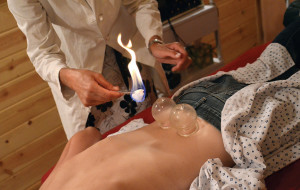
Rather than think about stretching those muscles, Evans prefers the term “lengthening.” She wants her classes to be gentle, meditative and relaxing.
“I have clients that are in their 80s coming to classes,” Evans said. “Anyone can do it. It really is a meditative practice. It’s a very slow moving process that asks us first of all to focus on our breath.”
Many of Evans’s clients deal with pain, a common theme among Door County holistic healthcare practitioners.
“A lot of people come to acupuncture as a last resort because they’ve tried everything else,” Beadell said. “I prefer they hadn’t tried surgery first, because then they have pins and needles in their bodies. I just wish people would think of me a little earlier.”
The Nelson Healing Center also has options for patients dealing with pain and trauma-related injuries, like massage therapy, myofascial release therapy, acupuncture and chiropractic services. Practitioners at the Nelson Healing Center focus on touch and make sure to take plenty of time to talk with patients about their health and lifestyles.
Antonia and Melissa Nelson are sisters who come from a health-oriented family. Their father was very interested in vitamins, minerals and integrated forms of health before the practices were popular. When one of them was sick with an ear infection, he would call a chiropractor to clear it up.
They passed down the love of healing to Antonia’s son Josh, who was treated at birth by Melissa. He became a massage therapist because that’s the way he’s been treated his whole life and felt the benefits after tough sports practices and a car accident.
Moriarty also came from a family of healers. Her father John Turk was one of the founders of the Door County Medical Center, and his partner Dave Conger was an acupuncturist and studied Eastern medicine. She became fascinated with it, and eventually took up the pursuit of alternative healing, although she focuses on Western herbal medicine instead of Eastern.
Moriarty’s first experience with alternative medicine was with the Neti Pot, now commonly accepted as a treatment for sinus problems. But when she took the device to her doctor in college, he told her using it was a mistake.
Years later, he’s jumped on board with the Neti Pot, and Moriarty is a successful herbalist and owner of Herbologie in Fish Creek.
Moriarty doesn’t hop on board with every alternative treatment, but she has a respect for tradition and appreciates that herbal medicine has stood up for thousands of years – practices passed down from mother to daughter. Western medicine even takes its cues from traditional medicine by synthesizing the most active compounds of medicinal plants.
“We’ve never just gone out and found something and figured out what to do with it,” Moriarty said. “We always start with traditional medicine, which is important. The grannies all believed in fermented foods and yogurts, and science is just catching up to how important these foods are.”
A reverence for ancient medicine hasn’t kept Moriarty from being a self-proclaimed science geek. Although she isn’t licensed – there is no licensing for Western herbalists – she understands modern and traditional herbal medicine and is always looking for more knowledge.
Regulation, or a lack of it, is a mixed blessing for many holistic healthcare practitioners in Door County and around the country. To be covered by insurance, procedures almost always need to be regulated and licensed, meaning patients have to pay out of pocket for most alternative treatments.
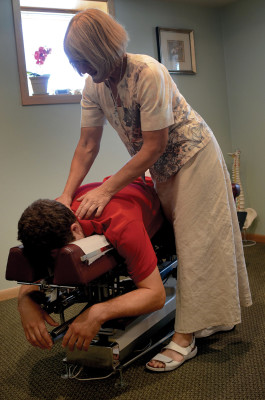
Insurance providers rarely recognize herbalists like doctors, or the benefits of massage therapy like those of physical therapy. When insurance coverage isn’t available, it can be hard for people to make the initial financial investment.
But there is an upside to not having insurance cover healthcare practices. Insured options need to be regulated, meaning large corporations would try to get in on the game. That can lead to more hoops to jump through for bodywork practitioners and more mechanized production of herbal medicines.
That’s one reason Moriarty owns her own business. She makes her medicines in the commercial kitchen in the back of her store from herbs she grows herself or buys in small quantities from other organic producers. She then makes tinctures, salves, pills or honey-based mixtures to make the most effective medicine.
The freedom that comes with working as a holistic healer makes for meaningful work. The practitioners I spoke to were enthusiastic about explaining their practices, about teaching Door County the benefits of holistic health and about helping their patients live healthy, balanced lives.
“That’s what’s fun about working here,” said Melissa Nelson. “We see miracles happen every day.”
Glossary of terms
Acupuncture is an ancient Eastern form of medicine that opens up energy flow in the body and restores patients to balanced qi, or energy. It’s done by inserting small needles into specific points along meridians, or channels that transport qi. The World Health Organization recognizes acupuncture as treatment for a number of health issues, including arthritis, neck pain and stroke.
Moxibustion is the process of burning mugwort, an herb, either on an acupuncture needle or directly on the skin, to rid the body of excess moisture. Moxibustion is often used to turn breech fetuses and stimulate menstruation.
Cupping is done to relieve tension and pain and to reduce chronic nausea. Cups are placed over a patient’s skin, then heated or pumped to create a suction.
Myofascial release therapy works the fascial system, made of connective tissue that surrounds every cell in the body. It is effective for pain relief, restricted movements, posture problems and other conditions. Treatment involves gentle, sustained pressure on the myofascial connective tissue.
Massage therapy is for more than just relaxation. Therapeutic massage can also boost the immune system, increase circulation and help remove toxins from the body.
A SCENAR device is a handheld biofeedback tool that stimulates the body’s nervous system. The tool is used in Russia and Europe to treat chronic conditions, pain, diseases, injuries and more.
Critical alignment therapy is a form of yoga therapy that focuses on releasing the superficial movement muscles and strengthening the deep postural muscles.
Photography by Katie Sikora.


